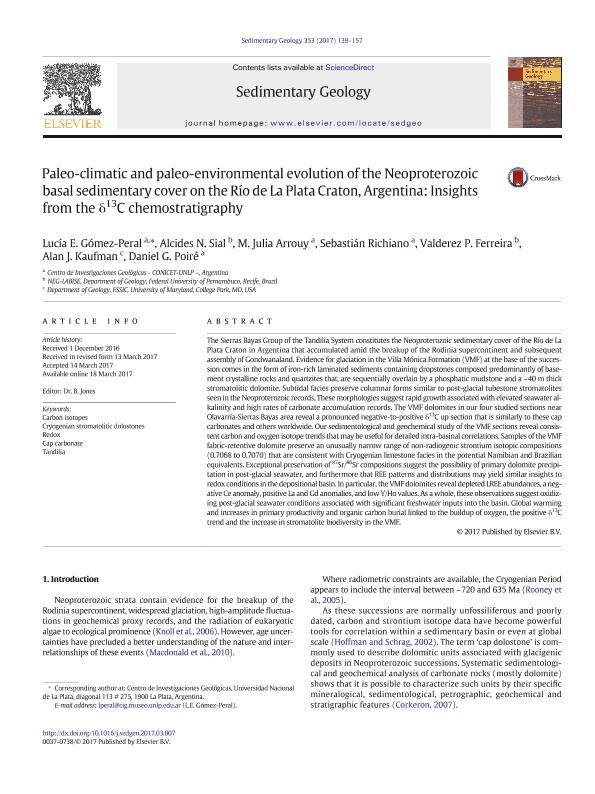Mostrar el registro sencillo del ítem
dc.contributor.author
Gómez Peral, Lucia

dc.contributor.author
Sial, Alcides N.
dc.contributor.author
Arrouy, Maria Julia

dc.contributor.author
Richiano, Sebastián Miguel

dc.contributor.author
Ferreira, Valderez P.
dc.contributor.author
Kaufman, Alan J.
dc.contributor.author
Poire, Daniel Gustavo

dc.date.available
2018-06-19T15:18:30Z
dc.date.issued
2017-05
dc.identifier.citation
Gómez Peral, Lucia; Sial, Alcides N.; Arrouy, Maria Julia; Richiano, Sebastián Miguel; Ferreira, Valderez P.; et al.; Paleo-climatic and paleo-environmental evolution of the Neoproterozoic basal sedimentary cover on the Río de La Plata Craton, Argentina: Insights from the δ13C chemostratigraphy; Elsevier Science; Sedimentary Geology; 353; 5-2017; 139-157
dc.identifier.issn
0037-0738
dc.identifier.uri
http://hdl.handle.net/11336/49257
dc.description.abstract
The Sierras Bayas Group of the Tandilia System constitutes the Neoproterozoic sedimentary cover of the Río de La Plata Craton in Argentina that accumulated amid the breakup of the Rodinia supercontinent and subsequent assembly of Gondwanaland. Evidence for glaciation in the Villa Mónica Formation (VMF) at the base of the succession comes in the form of iron-rich laminated sediments containing dropstones composed predominantly of basement crystalline rocks and quartzites that, are sequentially overlain by a phosphatic mudstone and a ~ 40 m thick stromatolitic dolomite. Subtidal facies preserve columnar forms similar to post-glacial tubestone stromatolites seen in the Neoproterozoic records. These morphologies suggest rapid growth associated with elevated seawater alkalinity and high rates of carbonate accumulation records. The VMF dolomites in our four studied sections near Olavarría-Sierras Bayas area reveal a pronounced negative-to-positive δ13C up section that is similarly to these cap carbonates and others worldwide. Our sedimentological and geochemical study of the VMF sections reveal consistent carbon and oxygen isotope trends that may be useful for detailed intra-basinal correlations. Samples of the VMF fabric-retentive dolomite preserve an unusually narrow range of non-radiogenic strontium isotopic compositions (0.7068 to 0.7070) that are consistent with Cryogenian limestone facies in the potential Namibian and Brazilian equivalents. Exceptional preservation of 87Sr/86Sr compositions suggest the possibility of primary dolomite precipitation in post-glacial seawater, and furthermore that REE patterns and distributions may yield similar insights to redox conditions in the depositional basin. In particular, the VMF dolomites reveal depleted LREE abundances, a negative Ce anomaly, positive La and Gd anomalies, and low Y/Ho values. As a whole, these observations suggest oxidizing post-glacial seawater conditions associated with significant freshwater inputs into the basin. Global warming and increases in primary productivity and organic carbon burial linked to the buildup of oxygen, the positive δ13C trend and the increase in stromatolite biodiversity in the VMF.
dc.format
application/pdf
dc.language.iso
eng
dc.publisher
Elsevier Science

dc.rights
info:eu-repo/semantics/openAccess
dc.rights.uri
https://creativecommons.org/licenses/by-nc-sa/2.5/ar/
dc.subject
Cap Carbonate
dc.subject
Carbon Isotopes
dc.subject
Cryogenian Stromatolitic Dolostones
dc.subject
Redox
dc.subject
Tandilia
dc.subject.classification
Meteorología y Ciencias Atmosféricas

dc.subject.classification
Ciencias de la Tierra y relacionadas con el Medio Ambiente

dc.subject.classification
CIENCIAS NATURALES Y EXACTAS

dc.title
Paleo-climatic and paleo-environmental evolution of the Neoproterozoic basal sedimentary cover on the Río de La Plata Craton, Argentina: Insights from the δ13C chemostratigraphy
dc.type
info:eu-repo/semantics/article
dc.type
info:ar-repo/semantics/artículo
dc.type
info:eu-repo/semantics/publishedVersion
dc.date.updated
2018-06-18T21:21:04Z
dc.journal.volume
353
dc.journal.pagination
139-157
dc.journal.pais
Países Bajos

dc.journal.ciudad
Amsterdam
dc.description.fil
Fil: Gómez Peral, Lucia. Consejo Nacional de Investigaciones Científicas y Técnicas. Centro Científico Tecnológico Conicet - La Plata. Centro de Investigaciones Geológicas. Universidad Nacional de La Plata. Facultad de Ciencias Naturales y Museo. Centro de Investigaciones Geológicas; Argentina
dc.description.fil
Fil: Sial, Alcides N.. Universidade Federal de Pernambuco; Brasil
dc.description.fil
Fil: Arrouy, Maria Julia. Consejo Nacional de Investigaciones Científicas y Técnicas. Centro Científico Tecnológico Conicet - La Plata. Centro de Investigaciones Geológicas. Universidad Nacional de La Plata. Facultad de Ciencias Naturales y Museo. Centro de Investigaciones Geológicas; Argentina
dc.description.fil
Fil: Richiano, Sebastián Miguel. Consejo Nacional de Investigaciones Científicas y Técnicas. Centro Científico Tecnológico Conicet - La Plata. Centro de Investigaciones Geológicas. Universidad Nacional de La Plata. Facultad de Ciencias Naturales y Museo. Centro de Investigaciones Geológicas; Argentina
dc.description.fil
Fil: Ferreira, Valderez P.. Universidade Federal de Pernambuco; Brasil
dc.description.fil
Fil: Kaufman, Alan J.. University of Maryland; Estados Unidos
dc.description.fil
Fil: Poire, Daniel Gustavo. Consejo Nacional de Investigaciones Científicas y Técnicas. Centro Científico Tecnológico Conicet - La Plata. Centro de Investigaciones Geológicas. Universidad Nacional de La Plata. Facultad de Ciencias Naturales y Museo. Centro de Investigaciones Geológicas; Argentina
dc.journal.title
Sedimentary Geology

dc.relation.alternativeid
info:eu-repo/semantics/altIdentifier/doi/https://dx.doi.org/10.1016/j.sedgeo.2017.03.007
dc.relation.alternativeid
info:eu-repo/semantics/altIdentifier/url/https://www.sciencedirect.com/science/article/pii/S0037073817300738
Archivos asociados
